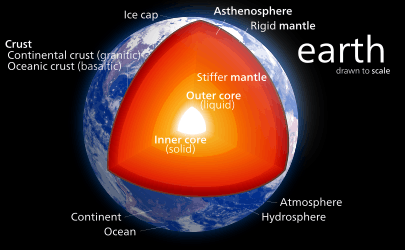Outer core

The outer core of the Earth is a fluid layer about 2,300 km (1,400 mi)[1] thick and composed of mostly iron and nickel that lies above Earth's solid inner core and below its mantle. Its outer boundary lies 2,890 km (1,800 mi) beneath Earth's surface. The transition between the inner core and outer core is located approximately 5,150 km (3,200 mi) beneath the Earth's surface. Unlike the inner core, the outer core is not solid. This is also referred to as the "liquid core".
Properties
Estimates for the temperature of the outer core are about 3,000–4,500 K (2,730–4,230 °C; 4,940–7,640 °F) in its outer regions and 4,000–8,000 K (3,730–7,730 °C; 6,740–13,940 °F) near the inner core.[2] Evidence for a fluid outer core includes observations from seismology which shows that seismic shear-waves are not transmitted through the outer core.[3] Because of its high temperature, modeling work has shown that the outer core is a low viscosity fluid that convects turbulently.[2] Eddy currents in the nickel iron fluid of the outer core are believed to influence the Earth's magnetic field. The average magnetic field strength in the Earth's outer core was measured to be 2.5 millitesla, 50 times stronger than the magnetic field at the surface.[4][5] The outer core is not under enough pressure to be solid, so it is liquid even though it has a composition similar to that of the inner core. Sulfur and oxygen could also be present in the outer core.[6]
As heat is transferred outward toward the mantle, the net trend is for the inner boundary of the liquid region to freeze, causing the solid inner core to grow. This growth rate is estimated to be 1 mm per year.[7]
See also
References
- ↑ http://education.nationalgeographic.com.au/education/encyclopedia/core/?ar_a=1
- 1 2 De Wijs, Gilles A.; Kresse, Georg; Vočadlo, Lidunka; Dobson, David; Alfè, Dario; Gillan, Michael J.; Price, Geoffrey D. (1998). "The viscosity of liquid iron at the physical conditions of the Earth's core" (PDF). Nature. 392 (6678): 805. Bibcode:1998Natur.392..805D. doi:10.1038/33905.
- ↑ Jeffreys, Harold (1926-06-01). "The Rigidity of the Earth's Central Core.". Monthly Notices of the Royal Astronomical Society. 1: 371–383. doi:10.1111/j.1365-246X.1926.tb05385.x. ISSN 1365-246X.
- ↑ First Measurement Of Magnetic Field Inside Earth's Core. Science20.com. Retrieved on 2012-01-27.
- ↑ Buffett, Bruce A. (2010). "Tidal dissipation and the strength of the Earth's internal magnetic field". Nature. 468 (7326): 952–4. Bibcode:2010Natur.468..952B. doi:10.1038/nature09643. PMID 21164483.
- ↑ Gubbins, David; Sreenivasan, Binod; Mound, Jon; Rost, Sebastian (May 19, 2011). "Melting of the Earth's inner core". Nature. 473 (7347): 361–363. Bibcode:2011Natur.473..361G. doi:10.1038/nature10068. PMID 21593868.
- ↑ Waszek, Lauren; Irving, Jessica; Deuss, Arwen (2011). "Reconciling the hemispherical structure of Earth's inner core with its super-rotation". Nature Geoscience. 4: 264–267. doi:10.1038/ngeo1083.
External links
| The Wikibook Historical Geology has a page on the topic of: Structure of the Earth |